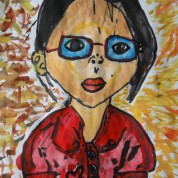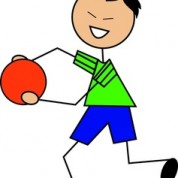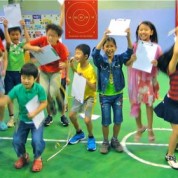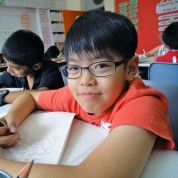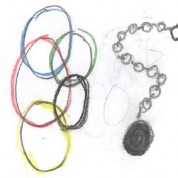Awesome Artwork
Last week, Diana painted this fantastic portrait of a classmate. She worked on the painting for 4 days, with some frustration and lots of persistence. She used these strategies to achieve success: – drawing basic shapes – researching face proportions – observing and photographing the person – adding details and outlines – asking Miss Davies for advice – adding shadows and highights – mixing colors and tones – using different brushstrokes Congratulations Diana! What do you like about this painting? Can you recognise a famous artist’s style...
Read MoreTaking Over as Teachers
For two weeks, we are taking over as teachers! We have each made a plan to improve in one area of strength and one area of weakness. We set goals, planned strategies and gathered equipment. We are now putting our plans into action for 1 lesson per day, for 8 days in a row. We are pre-testing ourselves, using strategies and trying to stay committed to our goals. Each day, we are reflecting on challenges, writing about strategies that worked and planning different strategies for the next day. It’s really fun to be independent but sometimes it’s frustrating, too. It takes a lot of commitment. We are glad our teachers and friends are there when we face challenges or need new strategies. Here are some people working on their action plans: What challenges are you facing? Are you improving? How do you...
Read MoreAverage Adam – Our Imaginary Friend
UPDATE! Today we finished our data investigation called Who Are We? After collecting lots of data about the people in our class, we could finally answer the question: Who is the average Grade 4 student? It was a little tricky to give a final answer. We had to organise our data and think carefully about whether to use the mean, median or mode for each category. Would you like to meet the average student? It turns out that no-one in our class fits the profile. We created Average Adam to be our imaginary friend and represent us all. Read about his features below. Average Adam Average Adam is a boy. He is 9 years and 6 months old and his birthday is in December. He is 137.5cm tall and he can jump a distance of 126.5cm. Adam has been at BISS for 1 year and he travels to school by bus. He loves Maths and his strength is logical intelligence. Adam’s favorite colour is blue. How do you compare with Adam? How are you similar? How are you...
Read MoreWho are we? (A Data Investigation)
This month, we have been getting to know each other through Mathematics. We’ve been writing questions, designing surveys and collecting lots of data about our classmates. We’ve learned to find and interpret the mean, median, mode & range of data sets. We’ve learned to use different graphs for different purposes. We’ve discovered the importance of scale and labels on our own graphs. We’ve gathered data on our ages, learning strengths, birthday months, time at BISS and modes of transport. We even measured our heights and jump lengths. Here we are, busily collecting data: In the end, we hope to describe our class composition and even answer the question: Who is the average Grade 4 student? Stay tuned for our...
Read MoreStrategies make all the difference.
The word of the week in Grade 4 is strategy. We have learned that applying the right strategies makes all the difference to our learning. This week, each person chose 2 learning stations: one represented an area of strength and one was an area of weakness. We pre-tested ourselves, then applied some learning strategies, then tested ourselves again. For example, at the logical station, people made lists, drew pictures and found patterns to solve hard Maths problems. At the musical station, people clapped rhythms, sang melodies and wrote the letters above the notes. At the visual-spatial station, people used basic shapes, shadows and hatching to improve their drawings. Here’s someone at the musical intelligence. Look at that concentration! Here’s someone at the bodily-kinesthetic station. Their strategies were watching the ball, keeping the bounces low and only moving their wrists. We’ve had great fun this week but Ms O’Dwyer designed the tasks. Next week, we are in charge of our own potential! We are making action plans and taking charge of our own strengths and weaknesses. Stay tuned! Which strategies worked well at each station? Which strategies didn’t work? Did you use more than one intelligence at each station? Tell us about this....
Read MoreDoodling Designers
Yesterday we strengthened our visual spatial intelligence. We asked our art teacher, Miss Davies, to help us understand how visual intelligence is useful in the world. She told us about people who are architects, graphic designers, advertisers, fashion designers and typographers. Inspired by the designers at Google, we decided to re-design our own names. We aimed to use line, colour, theme and shadow to create eye-catching images and fill a space. Here are some examples: Can you recognise our names? Which is your favorite? What can you learn about a person just by looking at their design? Miss Davies is now helping us strengthen our visual-spatial intelligence even further. In Art lessons, we are becoming real typographers and designing a whole alphabet of letters. Stay tuned to see our display...
Read More


